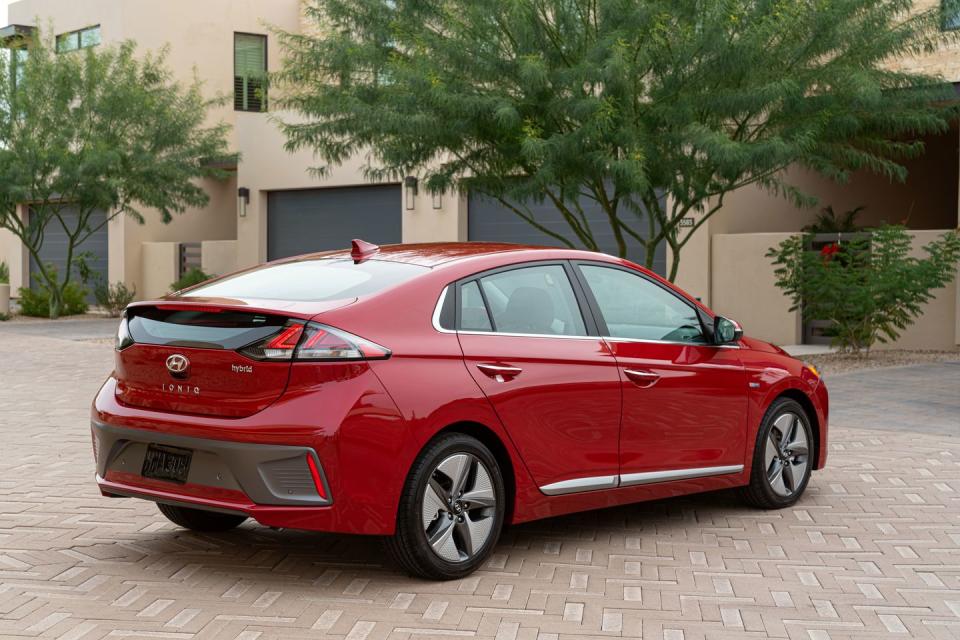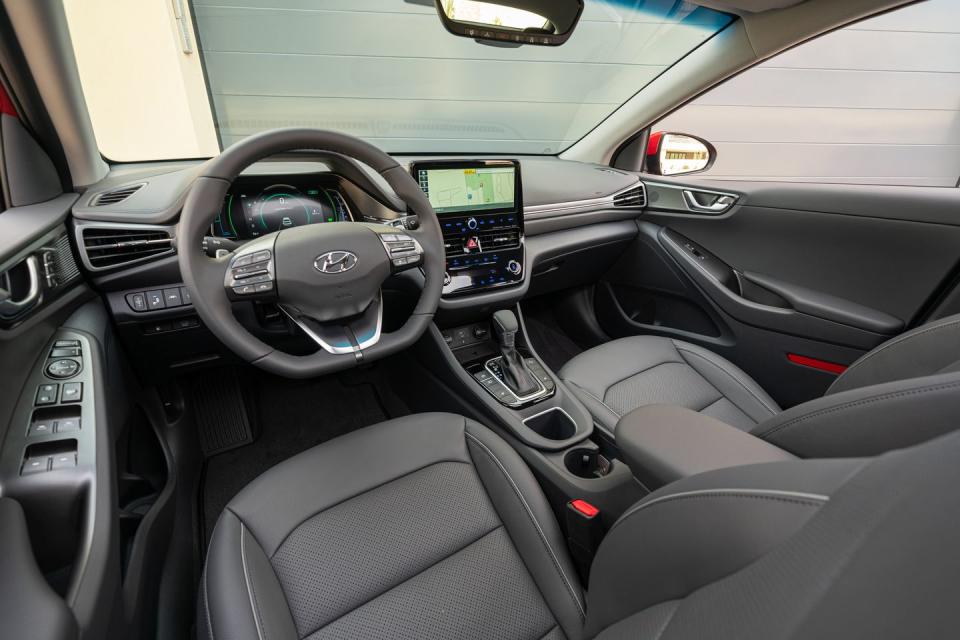2020 Hyundai Ioniq Hybrid Offers a Compelling Alternative to the Toyota Prius

Ever since the Hyundai Ioniq debuted for 2017, it's been fair to think of it as a marginally more fuel-efficient and less-bizarre-looking alternative to the Toyota Prius. That's still much the case. Hyundai's eco-minded hatchback still looks like a windswept potato, just not one that's been styled on Alpha Centauri. And in the hybrid model's base Blue trim, its 58-mpg EPA combined estimate is as good as you'll get from any hybrid without a plug. But the Ioniq had room to improve and was in need of a better alignment with the brand's newer products. Enter the updated 2020 Ioniq, which brandishes some subtle yet meaningful upgrades.
As before, the Ioniq—and its Kia Niro crossover sibling—are unique in offering hybrid, plug-in hybrid, and full-electric variants. We're focusing on the Hyundai hybrid here, as the pricier plug-in isn't a huge step up in performance and the electric model continues to be sold in only 14 states. Hyundai's newer Kona Electric, which is EPA rated with 258 miles of range, also goes farther on a charge than the updated 170-mile Ioniq Electric. At $24,175 to start, the Ioniq Blue hybrid makes a compellingly rational case for the fuel-conscious buyer. Our Limited model's $32,175 price is still reasonable, but it is more than you'd pay for a mid-level Sonata Hybrid SEL ($30,875), which offers 192 horsepower but isn't quite as efficient.

Welcome Regeneration
The lines of the 2020 Ioniq hybrid are clearly dictated by aerodynamics rather than aesthetics. But there are new designs for the grille and the front and rear bumpers, as well as for the standard 15-inch and optional 17-inch wheels. It's a conservative, low-key effect, if a little more distinctive than before. The Ioniq won't be mistaken for a spaceship, although the faint hum that it emits when puttering around parking lots does make it sound like one to pedestrians. Arguably, the 2020 Ioniq's greatest improvement is the adoption of noticeable regenerative braking, which can be tailored in three increments via the paddles on its steering wheel. While deceleration in the strongest setting is not quite as linear as we'd like, the setup will almost bring the vehicle to a stop without touching the brake pedal, capturing a significant amount of energy around town. The Ioniq Electric gets an even more aggressive regeneration system that effectively makes for one-pedal driving in most situations.
Slot the hybrid's conventional shift lever into its Sport setting, and those steering-wheel paddles can control the shifts of the six-speed dual-clutch automatic—a welcome upgrade over the Prius's mushy continuously variable automatic transmission (CVT). In Sport, the Ioniq's steering effort also increases, its throttle response sharpens, and the engine always stays running. But with lifeless steering and a mere 104 horsepower from its 1.6-liter inline-four—which makes for a 139-hp combination with the 43-hp motor-generator that's powered by a 1.6-kWh lithium-ion battery pack beneath the rear seat—there's little reason to get excited behind the wheel of this Hyundai. The last Ioniq hybrid we tested, a 2017 model, needed 8.9 seconds to reach 60 mph. That's quicker than a Prius and sufficient to merge onto the highway without causing a pileup behind you, but it's hardly exhilarating. The Ioniq hybrid is in its element when cruising around town, sipping fuel. Unlike the Prius, there's no all-wheel-drive option. But there is a standard "12V reset" feature, which allows the Ioniq to give itself a jump-start using the hybrid battery to charge the 12-volt starter battery. Why can't all hybrids do that?

The Ioniq hybrid Limited's 55-mpg combined rating is slightly less than the federal estimate of 58 mpg for the lighter, entry-level Blue model. Like most hybrids, however, the Ioniq fares better on the EPA's test cycle than it does in the real world. Still, from our previous testing experience with the hybrid, an observed average of up to 45 mpg and a 52-mpg return on our 75-mph highway test are pretty solid. With a comparable Prius, we've recorded 47 mpg overall, yet only 46 mpg on our highway test.
Higher-Tech Trappings
Inside, the ergonomics and build quality of the updated Ioniq are quite good, and the overall environment will be familiar to anyone who's sat in a conventional Hyundai Elantra sedan. From the attractively sculpted steering wheel to the strategically arrayed shiny bits to the piano-black trim for the center-stack controls, Hyundai's current interior game is strong even in the budget space. The Ioniq earns extra eco cred for its interior materials. The front door panels, for instance, are made of recycled plastic, powdered wood, and volcanic stone. Our Limited model upsized the standard 4.2-inch display in the instrument cluster to an informative and easy-to-read 7.0-inch unit—which, unlike the Prius's centrally mounted gauge pod, is positioned directly in front of the driver. Its center stack was topped by Hyundai's optional 10.3-inch horizontal touchscreen that controls one of the more attractive and straightforward infotainment systems on the market (an 8.0-inch touchscreen is standard, up from last year's 7.0 incher).

The Ioniq hybrid's hatchback profile affords it 27 cubic feet of cargo space behind the rear seats. That's a few cubes more than in a Prius or the Ioniq plug-in and electric models, which sacrifice some cargo space for their larger batteries. It's easy to get comfortable in the supportive front seats. A couple six-footers will fit in the back seat with minimal complaint, although they probably won't want to stay back there for long. Additional updates for 2020 include standard forward-collision warning, automated emergency braking, lane-departure warning, and lane-keeping assist, as well as optional blind-spot monitoring and adaptive cruise control. Being a Hyundai, the Ioniq also carries a 10-year or 100,000-mile powertrain warranty and has lifetime coverage for its battery.
It's easy to like the 2020 Hyundai Ioniq for the same reasons that have made the slightly more expensive Prius a hybrid icon: excellent fuel economy, solid practicality, and reasonable affordability. The big difference is that the Hyundai does its thing without the Prius's zany flair. Of course, the same could be said of newer, stealthier compact hybrid sedans such as the Honda Insight and Toyota Corolla, but neither of those can quite match the Hyundai's EPA ratings. The Ioniq hybrid's updates don't make it any more fun to drive, but they do help keep it relevant for drivers who want extraordinary efficiency in an ordinary package.
You Might Also Like

